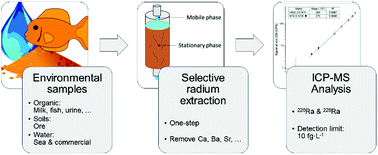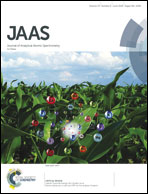Rapid, versatile and sensitive method for the quantification of radium in environmental samples through cationic extraction and inductively coupled plasma mass spectrometry†
Abstract
In this study, the method proposed by St-Amant et al. based on ionic chromatography was modified to rapidly quantify 226Ra and 228Ra by inorganic mass spectrometry in a broad variety of matrices at environmental levels. The sample volume loaded on the cationic resin AG50Wx8 was varied to achieve the highest possible adsorption without any significant loss of retention for radium. The pH and volume for the elution steps were optimized to obtain the highest pre-concentration factor and compatibility with plasma-based instruments and to eliminate interference to the maximum extent possible. Finally, inductively coupled plasma mass spectrometry (ICP-MS) instrumental conditions were investigated and optimized for the quantification of radium. An instrumental detection limit of 0.53 pg L−1 in 226Ra and 0.47 pg L−1 in 228Ra were achieved. When combined with the cationic separation procedure for interference removal, the overall method detection limit decreases to 10 fg L−1 in less than 2 hours.



 Please wait while we load your content...
Please wait while we load your content...